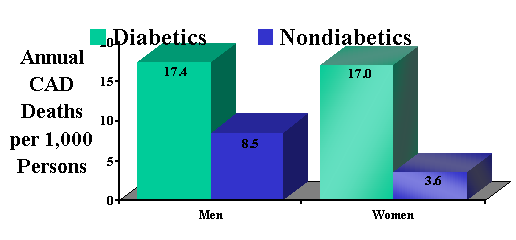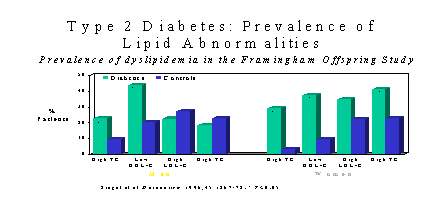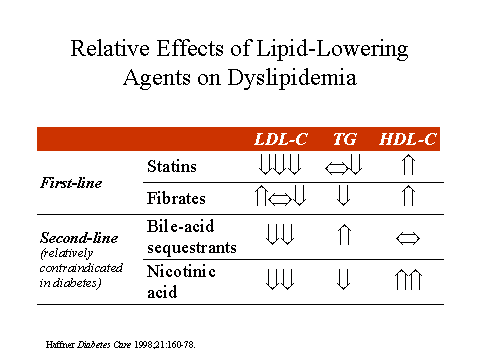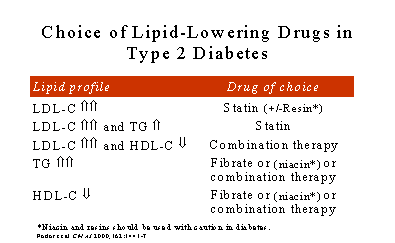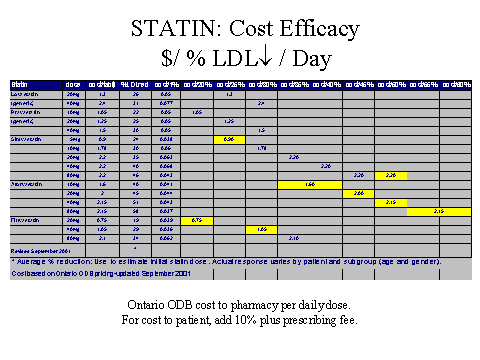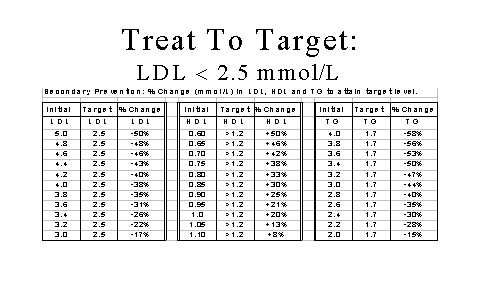
|
|
||||||||||||||
| The explosive increase in prevalence of Type 2 Diabetes in the new millennium will have a major impact on our society where in the next 10 years; 3 million Canadians will be affected.
While the UKPDS has shown us that glycemic control will improve the toll of microvascular disease, the main cause of death in diabetics is cardiovascular disease; outcomes of which are less affected by glycemic control. There is something strange about diabetics that makes diabetics more likely than others to develop cardiovascular disease; and when they do develop this disease, it is more likely to kill them. Most diabetics die a cardiovascular death.
Some of the explanation for the excess mortality in Type 2 Diabetics may be linked to the fact that 50-70% of Diabetics have abnormal lipids. While the incidence of elevated Cholesterol and LDL is about the same as the general population at 44%; the hallmark of Diabetic Dyslipidemia is an elevated Triglyceride level frequently coupled with low HDL. While studies have shown us that a 1% increase in LDL is associated with a 2% increase in cardiovascular disease; an even more dramatic relationship exists with HDL where a 1% lowering of HDL is associated with a 3% increase in cardiovascular disease risk.
The Canadian working group on Hypercholesterolemia and Other Dyslipidemias has recommended that Patients with Diabetes Mellitus over the age of 30 be classified as being at very high risk for Coronary Artery Disease.
Achieving Goals:
The data for the benefits of LDL lowering are very consistent & robust. I usually suggest starting with a statin if LDL>3.0. If Total Chol & LDL are normal or controlled, we look at HDL and Triglycerides. We know that a 1% reduction in HDL is associated with a 3% increase in risk of cardiovascular events. Statins produce a small 5-10% increase in HDL, this increase is generally unrelated to drug dose. The characteristic hypertriglyceridemia seen in hyperglycemia will respond to some extent to improved glycemic control but the depressed HDL is more resistant. Medications with beneficial effects on raising HDL and lowering Triglycerides are the fibrates and Niacin. Fibrates also have a beneficial effect on glycemic control because they act as PPAR-a agonists. Bezafibrate can decrease fasting Triglyceride by 50%, reduce Cholesterol by 12%, increase HDL by 20% and decrease Fasting Plasma Glucose by 16%. 3 In the DAIS study 4 treatment with Fenofibrate decreased Triglyceride by 30%, decreased Cholesterol by 10%, increased HDL by 10% and slowed the reduction of coronary artery lumen size. At what point should we pharmacologically treat isolated low HDL ? My threshold is HDL<0.8.
Fibrates:
Statins:
Resins: Bile acid sequestrants. Absorbs cholesterol containing bile acids which are then excreted in feces. May cause steatorrhea, may cause constipation. May impair absorption of fat soluble vitamins. May reduce absorption of warfarin.
Niacin: Water soluble B-complex vitamin. Reduces hepatic synthesis of VLDL and LDL, increases HDL. Lowers Chol by 10-15%, lowers Trig by 20-30%, raises HDL 30%. Do not use in liver disease, check liver functions; may worsen peptic ulcer; elevates uric acid; may worsen glucose control (doses >1500 mg). Frequently causes flushing which may be attenuated by taking ASA before niacin. May cause myositis if given with statins.
Other Agents: Salmon Oil
References
Case Study #1 Mr. F.
Mr. F. Lipids
Mr. F. after 3 months on statin
Case Study #2 Mrs. G. Age 49, accountant
|
||||||||||||||
